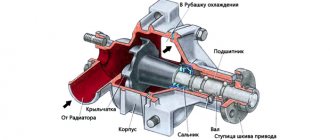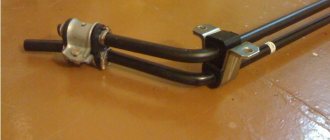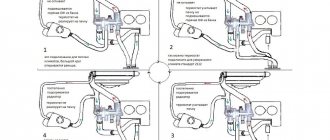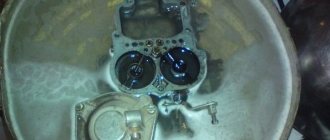Purpose of the thermostat on the VAZ 2106
The thermostat must control the degree of heating of the coolant and react in a timely manner when the antifreeze temperature becomes too high or, conversely, too low.
The thermostat maintains the temperature of the coolant in the engine cooling system in the desired range
The device can direct coolant through either a small or large cooling circle, thereby preventing the engine from overheating, or, conversely, helping it quickly warm up after a long period of inactivity. All this makes the thermostat the most important element of the VAZ 2106 cooling system.
Thermostat location
The thermostat in the VAZ 2106 is located to the right of the engine, where the pipes for discharging coolant from the main radiator are located. To see the thermostat, simply open the hood of the car. The convenient location of this part is a big plus when it becomes necessary to replace it.
To gain access to the VAZ 2106 thermostat, simply open the hood
Principle of operation
As mentioned above, the main task of the thermostat is to maintain the engine temperature within specified limits. When the engine needs to warm up, the thermostat blocks the main radiator until the engine reaches the optimal temperature. This simple measure can significantly extend the life of the engine and reduce wear on its components. The thermostat has a master valve. When the coolant reaches a temperature of 70 °C, the valve opens (it should be noted here that the opening temperature of the main valve can be higher - up to 90 °C, and this depends both on the design of the thermostat and on the thermal filler that is in it used).
Essentially, a thermostat is a regular valve that responds to changes in antifreeze temperature
The second important element of the thermostat is a special compression cylinder made of brass, inside of which there is a small piece of technical wax. When the antifreeze in the system reaches 80 °C, the wax in the cylinder melts. As it expands, it presses on the long rod connected to the main thermostat valve. The rod extends from the cylinder and opens the valve. And when the antifreeze cools, the wax in the cylinder begins to harden, and its expansion coefficient decreases. As a result, the pressure on the rod weakens and the thermostatic valve closes.
By opening the valve here we mean moving its leaf by only 0.1 mm. This is the initial opening value, which consistently increases by 0.1 mm as the antifreeze temperature rises by two to three degrees. When the coolant temperature rises by 20 °C, the thermostat valve opens fully. The full opening temperature can vary from 90 to 102 °C depending on the manufacturer and design of the thermostat.
The principle of operation and malfunctions of the thermostat on a car
So, for normal operation of the internal combustion engine while preserving its service life, it is necessary to constantly maintain the optimal temperature of the coolant. Simply put, the engine should not be too cold or too hot during operation.
It is for this reason that the operating temperature of the power unit must be kept within strictly defined limits. To do this, the working coolant (coolant, antifreeze or antifreeze) constantly circulates in the engine cooling system.
This coolant circulates through special channels that are made in the engine block and
cylinder head
. Also, from the engine through the pipes, antifreeze enters the cooling radiator, which is blown by oncoming air flows.
However, after the fluid temperature reaches about 85 degrees Celsius, the valve will begin to open, allowing some of the fluid to flow into the radiator. After heating the liquid to 98-100 degrees, the thermostat valve will open completely.
Then, when the coolant passes through the radiator and the temperature of the liquid drops, the valve will gradually close, which will reduce the flow of hot liquid from the engine to the radiator or completely shut off the supply. The result is automatic maintenance of the set engine temperature within certain limits (for example, 85-98 degrees Celsius).
In turn, this allows you to get the most out of the engine and increase its efficiency, burn fuel more efficiently, avoid coking and soot in the cylinders, increase exhaust toxicity, etc. In this case, the resource of the unit does not suffer, since the engine operates under optimal heating conditions (without overheating or underheating of the internal combustion engine).
Read more: Effective methods of combating car body corrosion. How to remove corrosion with your own hands
We also note that the thermostat is a completely autonomous solution that works thanks to the laws of physics. In short, such a valve is based on a solid-state heat-sensitive element that simply melts when heated.
As a result of melting, the valve opens. Then, after cooling, the temperature-sensitive element returns to its original state, which causes the valve to close. Thus, the thermostat allows the coolant to move only in a small circle (bypassing the radiator) or in a large circle (through the radiator).
Of course, like any device, a thermostat can fail over time. However, a faulty thermostat can cause serious problems.
To avoid consequences, it is important to know what the signs of a faulty thermostat are.
Among the main symptoms are:
- the engine does not warm up, takes a long time or does not reach operating temperatures at all, the heater blows cold air (the thermostat is stuck in the open position);
- the engine overheats for no other apparent reason, the cooling fan turns constantly (the thermostat does not open);
- the problem is floating, when at first the engine reaches operating temperatures, but then after several openings and closings of the thermostat, either overheating or severe cooling of the power unit begins (the thermostat partially or completely jams in the open or closed position);
Types of thermostats
The VAZ 2106 car was produced for many years. And during this time, engineers made a number of changes to it, including thermostats. Let's look at what thermostats were installed on the VAZ 2106 from the release of the first cars to the present day.
Single valve thermostat
Single-valve thermostats were installed on the very first “sixes” that rolled off the VAZ assembly line. The operating principle of this device has been described in detail above. To date, these devices are considered obsolete, and finding them on sale is not so easy.
The first “sixes” were equipped with the simplest, single-valve thermostats
Electronic thermostat
An electronic thermostat is the latest and most advanced modification that replaced single-valve devices. Its main advantages are high accuracy and reliability. Electronic thermostats have two operating modes: automatic and manual.
Electronic thermostats are used in modern cooling systems and differ from their predecessors in high accuracy and much greater reliability
Liquid thermostat
Thermostats are classified not only by design, but also by the type of fillers. Liquid thermostats were the very first to appear. The main component of a liquid thermostat is a small brass cylinder filled with distilled water and alcohol. The operating principle of this device is the same as that of the wax-filled thermostats discussed above.
Solid thermostat
The filler in such thermostats is ceresin. This is a substance similar in consistency to regular wax, which is mixed with copper powder and placed in a copper container. The cylinder has a rubber membrane connected to a rod, also made of dense rubber that is resistant to high temperatures. Ceresin, expanded from heating, presses on the membrane, which, in turn, acts on the rod and valve, ensuring the circulation of antifreeze.
The main element of a solid-fill thermostat is a container with ceresite and copper powder
Which thermostat is better
Today, thermostats based on solid fillers are considered the best option for the VAZ 2106, since they have the optimal combination of price and quality. In addition, they can be found in any auto store, unlike liquid single-valve ones, which are practically no longer on sale.
Which to choose
Model PEKAR
Before making a replacement, you need to figure out which thermostat is best to purchase. Based on the experience of the owners of this car, several options can be offered.
- Native. The VAZ 2114 is equipped with fairly mediocre thermostats, so replacing it with the same one makes no sense. Many experienced drivers immediately decide to install an analogue, even if the original element is working.
- Chinese equivalent. If you are wondering which device is better, we strongly do not recommend choosing a Chinese-made element. They are close in price to their relatives, but the quality is even worse. There is no need to save money here, since a more or less good unit costs around 300-400 rubles.
- Thermostats from Gates, Vernet and Wahler. It is these companies that show themselves as one of the best analogues for the fourteenth model. Their price of around 350 rubles allows you to purchase a truly high-quality part for little money.
Signs of a broken thermostat
There are a number of signs that clearly indicate that the thermostat is faulty:
- The light on the instrument panel is constantly on, indicating that the engine is overheating. This usually happens because the thermostat valve has closed and is stuck in that position;
- The engine warms up very poorly. This means that the thermostat valve does not close tightly. As a result, antifreeze flows through both the small and large cooling circles and cannot warm up in a timely manner;
- After the engine starts, the lower thermostat tube heats up literally within a minute. You can check this by simply placing your hand on the nozzle. This situation indicates that the thermostat valve is stuck in the fully open position.
If any of these symptoms are detected, the driver should replace the thermostat as soon as possible. If the car owner ignores the above symptoms, this will inevitably lead to overheating of the engine and its jamming. It is extremely difficult to restore an engine after such a breakdown.











